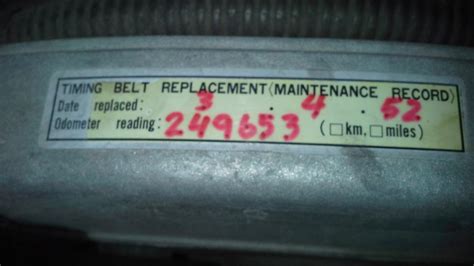How Can You Tell If Timing Belt Has Been Changed
Ronan Farrow
Mar 27, 2025 · 3 min read

Table of Contents
How Can You Tell if a Timing Belt Has Been Changed?
Knowing when your car's timing belt was last replaced is crucial for preventing potentially catastrophic engine damage. A broken timing belt can lead to bent valves, a destroyed engine, and a very expensive repair bill. But how can you tell if it's been changed, especially if you're buying a used car? Let's explore several methods.
Examining Service Records
The most reliable way to determine if a timing belt has been changed is by reviewing the vehicle's service history. Look for:
- Service records from a reputable mechanic or dealership: These records should clearly state the date, mileage, and the fact that the timing belt was replaced. They might also include the part number of the belt used.
- Maintenance logs: Some diligent car owners meticulously keep their own records of maintenance, including timing belt replacements. This information can be invaluable.
- Digital service history: Many modern cars store service records digitally. Check your car's onboard computer system or consult the manufacturer's website (if available).
Tip: Don't just rely on a verbal statement from a seller. Always get verifiable documentation!
Inspecting the Timing Belt (Not Recommended for Beginners)
While you could try visually inspecting the timing belt itself, this is generally not recommended unless you are experienced with car maintenance. Accessing the timing belt often requires removing various engine components, which is a complex and potentially dangerous process. Improper handling could damage the engine. Additionally, the belt's condition doesn't always definitively indicate when it was replaced. A new belt could show wear prematurely due to various factors.
Checking the Timing Belt Tensioner and Idler Pulleys
Inspecting the timing belt tensioner and idler pulleys might offer some clues, but it's not foolproof. These components often have wear indicators, which could reveal an approximate age. Again, this requires some mechanical knowledge and is not a DIY project for beginners.
- Look for signs of wear: Excessive corrosion, cracks, or significant wear on the pulleys can indicate they have been in use for a considerable time. This suggests the timing belt might be old, but it doesn't confirm its replacement history.
Examining the Water Pump
The water pump is often replaced at the same time as the timing belt. Therefore, examining the water pump could provide an indirect clue. However, this too is not a definitive method.
What to look for: A relatively new water pump implies a higher chance the timing belt was also replaced around the same time, but it's not a guarantee.
The Bottom Line: Prioritize Service Records
In conclusion, while several avenues exist to try and determine if a timing belt has been changed, the most accurate and reliable method is always to examine the vehicle's service records. If these records are unavailable or incomplete, proceed with caution. Consider getting a professional inspection from a qualified mechanic before purchasing a used vehicle, especially if the timing belt's replacement history is unclear. A faulty timing belt can be a costly and major inconvenience, so it's best to be certain before making a significant purchase.
Featured Posts
Also read the following articles
| Article Title | Date |
|---|---|
| How Do You Know When Geek Bar Is Finished | Mar 27, 2025 |
| How Do You Make Parched Corn | Mar 27, 2025 |
| How Far Does A 12 Gauge Bird Shot Travel | Mar 27, 2025 |
| How Big Is An 8oz Candle | Mar 27, 2025 |
| How Do You Turn Off Maintenance Light On Honda Accord | Mar 27, 2025 |
Latest Posts
Thank you for visiting our website which covers about How Can You Tell If Timing Belt Has Been Changed . We hope the information provided has been useful to you. Feel free to contact us if you have any questions or need further assistance. See you next time and don't miss to bookmark.
